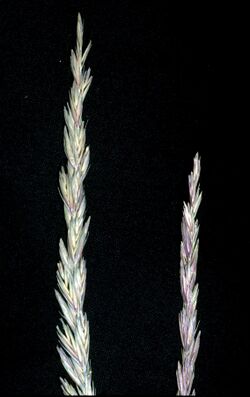Biology:Leymus triticoides
| Leymus triticoides | |
|---|---|

| |
| Scientific classification | |
| Kingdom: | Plantae |
| Clade: | Tracheophytes |
| Clade: | Angiosperms |
| Clade: | Monocots |
| Clade: | Commelinids |
| Order: | Poales |
| Family: | Poaceae |
| Subfamily: | Pooideae |
| Genus: | Leymus |
| Species: | L. triticoides
|
| Binomial name | |
| Leymus triticoides (Buckley) Pilg.
| |
| Synonyms | |
|
Elymus triticoides Buckley | |
Leymus triticoides, with the common names creeping wild rye and beardless wild rye, is a species of wild rye. It is native to western North America from British Columbia to California and Texas .
Habitat
Leymus triticoides often grows in moist habitat, sometimes with heavy and saline soils. It forms a solid root system which allows it to grow at water's edge and prevent the soil from eroding.[1]
Description
This rhizomatous, turf-forming perennial grass reaches 1.3 meters in maximum height. The stiff, slender green to blue-green leaves stand away from the stems at an obvious angle. The inflorescence is a narrow spike of flowers up to 20 centimeters long.
This is a good rangeland grass for grazing, and it is used to stabilize waterways because of its soil-retaining rhizome network.[2]
Leymus triticoides is an important native plant in California chaparral and woodlands habitat restoration projects.
See also
References
External links
- Jepson Manual Treatment - Leymus triticoides
- USDA Plants Profile: Leymus triticoides
- Leymus triticoides - Photo gallery
Wikidata ☰ Q6538098 entry
 |

